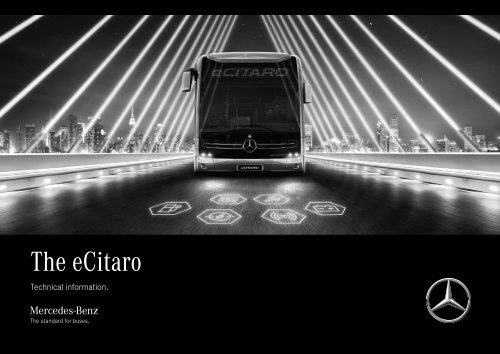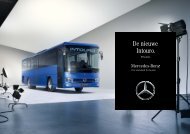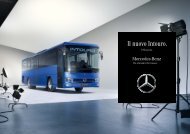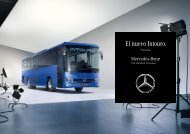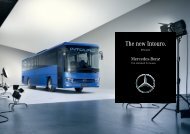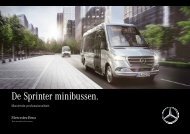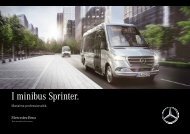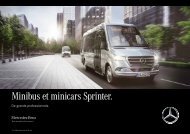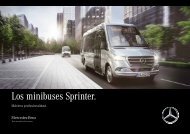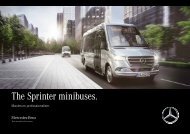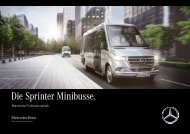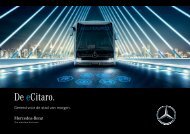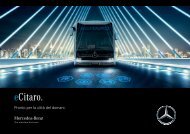Create successful ePaper yourself
Turn your PDF publications into a flip-book with our unique Google optimized e-Paper software.
The eCitaro<br />
Technical information.
Model designations<br />
eCitaro (C 628.630-13)<br />
530<br />
HAUPTBAHNHOF<br />
530<br />
eCitaro (C 628.631-13)<br />
530<br />
HAUPTBAHNHOF<br />
530<br />
2
eCitaro G (C 628.640-13)<br />
530<br />
HAUPTBAHNHOF<br />
530<br />
eCitaro G (C 628.641-13)<br />
530<br />
HAUPTBAHNHOF<br />
530<br />
3
Dimensions and weights<br />
eCitaro, 2 doors eCitaro, 3 doors eCitaro G, 3 doors eCitaro G, 4 doors<br />
Vehicle length 12,135 mm 12,135 mm 18,125 mm 18,125 mm<br />
Vehicle width/Vehicle width (incl. mirrors) 2,550/2,950 mm 2,550/2,950 mm 2,550/2,950 mm 2,550/2,950 mm<br />
Vehicle height (max. vehicle height results from customer-specific antennas) 3,400 mm 3,400 mm 3,400 mm 3,400 mm<br />
Wheelbase, front axle-drive axle 5,900 mm 5,900 mm -- --<br />
Wheelbase, front axle-centre axle -- -- 5,900 mm 5,900 mm<br />
Wheelbase, centre axle-drive axle -- -- 5,990 mm 5,990 mm<br />
Front/rear overhang 2,805/3,430 mm 2,805/3,430 mm 2,805/3,430 mm 2,805/3,430 mm<br />
Angle of approach/departure 7°/7° 7°/7° 7°/7° 7°/7°<br />
Tyre size 275/70 R 22.5 275/70 R 22.5 275/70 R 22.5 275/70 R 22.5<br />
Total passenger carrying capacity (<strong>EC</strong>E R107) with NMC1<br />
- Vehicle with 6 batteries (Standard) 1/85 (Standard) 1/83 -- --<br />
- Vehicle with 8 batteries 74 78 (Standard) 1/151 (Standard) 1/151<br />
- Vehicle with 10 batteries 71-85*** 70-82*** 143 143<br />
- Vehicle with 12 batteries 70-76*** 69-75*** 135 135<br />
Total passenger carrying capacity (<strong>EC</strong>E R107) with solid-state batteries<br />
- Vehicle with 6 batteries (Standard) 88 (Standard) 85 141 142<br />
- Vehicle with 7 batteries 74 76 (Standard) 135 (Standard) 136<br />
Seats (standard) 29 26 45 41<br />
Boarding height, door 1—4 320/320/--/-- mm 320/320/320/-- mm 320/320/320/-- mm 320/320/320/320 mm<br />
Standing height front/rear 2,313/2,021 mm 2,313/2,021 mm 2,313/2,021 mm 2,313/2,021 mm<br />
Height of floor above road surface 370 mm 370 mm 370 mm 370 mm<br />
Waistline height (above floor) 952 mm 952 mm 952 mm 952 mm<br />
Energy content, batteries NMC1, 6/8/10/12 pcs. 146/194/243/292 kWh 146/194/243/292 kWh --/194/243/292 kWh --/194/243/292 kWh<br />
Energy content, batteries NMC2, 6/8/10/12 pcs. 198/264/330/396 kWh 198/264/330/396 kWh --/264/330/396 kWh --/264/330/396 kWh<br />
Energy content, Solid state battery, 6/7 pcs. 378/441 kWh 378/441 kWh 378/441 kWh 378/441 kWh<br />
Gross vehicle weight 20,000 kg 20,000 kg 20,000 kg 20,000 kg<br />
Axle loads, max. permissible*<br />
- Front axle** 7.500 kg 7.500 kg 7.500 kg 7.500 kg<br />
- Centre axle -- -- 10,000 kg 10,000 kg<br />
- Drive axle 13,000 kg 13,000 kg 13,000 kg 13,000 kg<br />
* technical gross axle rating depending on the country of registration (Germany as an example) ** Front axle can be mounted on 8 to, tyre size 315/60 R 22.5 *** depending on cluster position<br />
4
Turning circle<br />
A C B<br />
A<br />
C<br />
m<br />
n<br />
F<br />
E<br />
54°<br />
B<br />
E<br />
D<br />
F<br />
D<br />
eCitaro, 2/3 doors eCitaro G, 3/4 doors<br />
A: Front overhang 2,805 mm 2,805 mm<br />
B: Rear overhang 3,430 mm 3,430 mm<br />
C: Wheelbase 5,900 mm 5,900 mm<br />
m+n: Wheelbase, centre axle — drive axle -- 5,990 mm<br />
D: Minimum turning circle 21,214 mm 22,928 mm<br />
E: Minimum track circle 17,058 mm 19,160 mm<br />
F: Swept annular width — minimum turning circle 6,803 mm 7,478 mm<br />
D: BOKraft turning circle 25,000 mm 25,000 mm<br />
F: BOKraft swept annular width 5,851 mm 6,791 mm<br />
F: Maximum permissible swept annular width according to BOKraft 7,200 mm 7,200 mm<br />
Maximum front axle turning angle, inside/outside wheel 53°/46° 47/38°<br />
All dimensions apply to tyre sizes 275/70 R 22.5 and 315/60 R 22.5<br />
5
Drive train/Technology<br />
Battery cooler<br />
Power inverter<br />
CO 2<br />
air-conditioning system with heat pump<br />
Battery assembly (roof)<br />
Battery assembly (rear)<br />
DCCU charging control unit<br />
Drive axle ZF AVE 130<br />
with wheel hub drive<br />
Charging socket<br />
Front axle ZF 82 RL <strong>EC</strong>, independent wheel suspension<br />
Drive<br />
Drive axle with two wheel hub motors<br />
Rated voltage<br />
400 V<br />
Output (peak/continuous)<br />
250 kW / 125kW<br />
Max. torque<br />
2 x 485 Nm<br />
acc. to final drive ratio<br />
2x 11.000 Nm<br />
Steering<br />
intelligent eco steering (electrohydraulic steering)<br />
Axles<br />
– Front axle ZF 82 RL <strong>EC</strong>, independent wheel suspension<br />
– Centre axle (articulated bus standard equipment, optionally driven ZF AVE 130) ZF AV 133<br />
– Drive axle ZF AVE 130<br />
Brakes<br />
Electropneumatic brake system with disc brakes<br />
Anti-lock Braking System (ABS)/ Acceleration Slip Regulation (ASR)/Electronic Stability Program (ESP ® )/Anti-jackknife ATC (Articulation Turntable Controller)<br />
Wear-free brakes thanks to recuperation<br />
6
Modular concept for batteries NMC* technology / Solid state batteries<br />
Technology Solid state battery NMC battery Lithium ion battery<br />
Structure of battery modules 9 C<strong>MB</strong> battery cells with a total capacity of 63 kWh 12 prismatic battery cells, each with a capacity of 24kWh (NMC1)/33kWh (NMC2)<br />
Structure of cell modules - 15 cell modules incl. control unit for monitoring and charge compensation<br />
Number of high-voltage battery modules 6 - 7 pcs. 6 - 12 pcs<br />
Battery arrangement<br />
- Rear 2 modules 4 modules<br />
- Roof up to 5 modules up to 8 modules<br />
Capacity per battery module Approx. 63 kWh Approx. 24kWh (NMC1)/33kWh (NMC2)<br />
Max. total capacity of battery modules Approx. 441 kWh Approx. 292kWh (NMC1)/396 kWh (NMC2)<br />
Charging options<br />
- Combo2 charging plug (on exterior of the vehicle on the right above the front axle) Standard Standard<br />
- Pantograph power consumer not available Special equipment<br />
- Charging rail not available Special equipment (06/2021)<br />
* NMC - nickel-manganese-cobalt<br />
7
Seating variants eCitaro<br />
eCitaro, 2 doors (C 628.630-13)<br />
eCitaro, 3 doors (C 628.631-13)<br />
21 17 13<br />
22 18 14<br />
8<br />
5<br />
3<br />
1<br />
22 18 14 10 7<br />
23 19 15 11<br />
4<br />
5<br />
1<br />
2<br />
27<br />
24<br />
29<br />
29<br />
25<br />
26<br />
23 19 15 11<br />
24 20 16 12<br />
9<br />
10<br />
6<br />
7<br />
4<br />
2<br />
25<br />
26<br />
20 16 12<br />
21 17 13<br />
9<br />
8 6<br />
3<br />
Standard: Number of seats: 1/29<br />
Standard: Number of seats: 1/26<br />
17 13 9 5<br />
29 25 21 1<br />
29 25 21<br />
17 13 9 5<br />
1<br />
26 22 18 14<br />
30 10 6 2<br />
26 22 18 14<br />
30 10 6 2<br />
35<br />
31<br />
36<br />
33 31 27 23 19 15 11 7 3<br />
32<br />
27 23 19 15 11 7 3<br />
37<br />
34 32 28 24 20 16 12 8<br />
4<br />
33<br />
28 24 20 16 12 8<br />
4<br />
Special equipment (example) Number of seats: 1/37<br />
Special equipment (example): Number of seats: 1/33<br />
8
Seating variants eCitaro G<br />
eCitaro G, 3 doors (C 628.640-13)<br />
eCitaro G, 4 doors (C 628.641-13)<br />
37<br />
38<br />
33<br />
34<br />
29<br />
30<br />
27<br />
28<br />
25<br />
26<br />
21<br />
22<br />
17<br />
18<br />
13<br />
14<br />
8<br />
5<br />
3<br />
1<br />
37<br />
38<br />
33<br />
34<br />
29<br />
30<br />
27<br />
28<br />
25<br />
26<br />
21<br />
22<br />
17<br />
18<br />
13<br />
14<br />
8<br />
5<br />
3<br />
1<br />
43<br />
44<br />
45<br />
41<br />
42<br />
39<br />
40<br />
35<br />
36<br />
31<br />
32<br />
24 23<br />
19<br />
20<br />
15<br />
16<br />
11<br />
12<br />
9<br />
10<br />
6<br />
7<br />
4<br />
2<br />
39<br />
40<br />
41<br />
35<br />
36<br />
31<br />
32<br />
24 23<br />
19<br />
20<br />
15<br />
16<br />
11<br />
12<br />
9<br />
10<br />
6<br />
7<br />
4<br />
2<br />
Standard: Number of seats: 1/45<br />
Standard: Number of seats: 1/41<br />
31<br />
32<br />
27<br />
28<br />
24<br />
25<br />
20<br />
21<br />
16<br />
17<br />
13<br />
14<br />
10<br />
11<br />
7<br />
8<br />
4<br />
5<br />
1<br />
2<br />
42<br />
43<br />
38<br />
39<br />
34<br />
35<br />
32<br />
33<br />
30<br />
31<br />
27<br />
28<br />
23<br />
24<br />
19<br />
20<br />
15<br />
16<br />
11<br />
12<br />
7<br />
8<br />
4 1<br />
38<br />
39<br />
37 36 35<br />
33<br />
34<br />
29<br />
30<br />
26<br />
22<br />
23<br />
18<br />
19<br />
15<br />
12<br />
9<br />
6<br />
3<br />
44<br />
45<br />
46<br />
40<br />
41<br />
36<br />
37<br />
29<br />
25<br />
26<br />
21<br />
22<br />
17<br />
18<br />
13<br />
14<br />
9<br />
10<br />
5<br />
6<br />
2<br />
3<br />
Special equipment (example): Number of seats: 1/39<br />
Special equipment (example): Number of seats: 1/46<br />
9
Standard and special equipment (selected)<br />
Engine and running gear eCitaro eCitaro G<br />
Drive axle ZF AVE 130 with motors close to wheel hub ● ●<br />
Roll-pitch control ❍ ❍<br />
Batteries, 6 pcs./ NMC* ● -<br />
Batteries, 8 pcs./ NMC* ❍ -<br />
Batteries, 10 pcs./ NMC* ❍ ●<br />
Batteries, 12 pcs./ NMC* ❍ ❍<br />
Batteries, 6 pcs./ Solid state battery* ❍ ●<br />
Batteries, 7 pcs./ Solid state battery* ❍ ❍<br />
Charging plug on exterior of the vehicle (Combo2 charging socket) ● ●<br />
High-performance charging, contact arm (pantograph) ❍ ❍<br />
Electrohydraulic steering (intelligent eco steering) ❍ ❍<br />
Electropneumatic-Braking-System (EBS) ● ●<br />
Anti-lock Braking System (ABS) ● ●<br />
Acceleration Slip Regulation (ASR) ● ●<br />
Electronic Stability Program (ESP ® ) ● -<br />
Anti-jackknife ATC (Articulation Turntable Controller) - ●<br />
Front axle, 7.5 t ● ●<br />
Front axle, 8.0 t* ❍* ❍*<br />
Automatic bus stop brake with pull-away lock ● ●<br />
Air suspension via electronic level control system (<strong>EN</strong>R) ● ●<br />
Air suspension via electronic level control system (<strong>EN</strong>R), incl. kneeling ❍ ❍<br />
Vehicle lift 70 mm, with button on instrument panel/console ❍ ❍<br />
Tyre pressure monitoring system ❍ ❍<br />
Rough road running gear ❍ ❍<br />
* according to customer requirements<br />
10
Driver’s area eCitaro eCitaro G<br />
Driver’s seat GRAMMER Linea MSG 90.6 P, air-sprung ● ●<br />
3-point seat belt for driver’s seat ❍ ❍<br />
Seat heater for driver’s seat ❍ ❍<br />
Driver’s area air conditioning ● ●<br />
Driver’s cab door ● ●<br />
Compartment for driver’s bag at cab door, open ● ●<br />
Compartment for driver’s bag at cab door, lockable, hinged ❍ ❍<br />
Provision for a ticket machine printer ❍ ❍<br />
Steering column and instrument panel with height and tilt adjustment ● ●<br />
Cruise control ❍ ❍<br />
Front collision guard based on pendulum impact test as laid down in <strong>EC</strong>E R29 ● ●<br />
Sideguard Assist ❍ ❍<br />
Preventive Brake Assist ❍ ❍<br />
Heated exterior mirror with school bus approval ● ●<br />
Exterior mirrors heated, electrically adjustable with school bus approval ❍ ❍<br />
Driver’s microphone ❍ ❍<br />
Reversing buzzer ❍ ❍<br />
Reversing camera ❍ ❍<br />
Blind across 1/2 of windscreen, electrically operated ● ●<br />
Blind across 2/3 of windscreen, electrically operated ❍ ❍<br />
Fire detection system for engine compartment monitoring (only in conjunction with fossil auxiliary heater) ● ●<br />
Extinguishing system (only in conjunction with fossil auxiliary heater) ❍ ❍<br />
Rain-light sensor ❍ ❍<br />
Flat wiper blades with water fed through wiper blade ● ●<br />
● Standard equipment/Equipment at no extra charge<br />
❍ Optional extras<br />
11
Interior eCitaro eCitaro G<br />
Seating CityStarEco (CSE) ● ●<br />
Seating CityStarFunction (CSF) ❍ ❍<br />
New generation of folding seats ❍ ❍<br />
Wheelchair space ❍ ❍<br />
Wheelchair back wall with integrated fold-up seat ❍ ❍<br />
Stop request button ● ●<br />
Stowage on front wheel arch, left / right ❍ / ❍ ❍ / ❍<br />
Emergency hammers (no anti-theft device) ❍ ❍<br />
Emergency hammers secured with rope, automatic retractor ● ●<br />
Sidewall lining in needle felt ❍ ❍<br />
Design ceiling ● ●<br />
Ambient lighting with LEDs ❍ ❍<br />
Video recording system in passenger compartment ❍ ❍<br />
Information systems eCitaro eCitaro G<br />
Radio system for driver’s workstation ❍ ❍<br />
Multi-function antenna for radio, mobile phone, navigation ❍ ❍<br />
Bus stop display inside, cross duct ❍ ❍<br />
Destination system LED or LCD ❍ ❍<br />
Wheelchair button inside/outside ❍ ❍<br />
TFT monitors in the interior ❍ ❍<br />
Video monitor for driver’s workstation ❍ ❍<br />
12
Climate control eCitaro eCitaro G<br />
Turbo roof ventilator ● ●<br />
Evo Thermatik Plus roof-mounted air-conditioning system (CO 2<br />
air-conditioning system with heat pump) ● ●<br />
Automatic air-conditioning system for driver’s workstation ● ●<br />
Heating with side panel heating units ● ●<br />
Intelligent thermal management ● ●<br />
Outdoor temperature-controlled and load-dependent control of the indoor temperature ● ●<br />
Other eCitaro eCitaro G<br />
Cornering light ❍ ❍<br />
Daytime driving lights with LED technology ● ●<br />
Headlamps with LED technology ● ●<br />
Side windows heat-absorbing, grey tint ● ●<br />
Side windows double glazed ❍ ❍<br />
Hinged panes in side windows ● ●<br />
Folding ramp at Door 2, mechanical ❍ ❍<br />
Modular ramp at Door 2, electric ❍ ❍<br />
● Standard equipment/Equipment at no extra charge<br />
❍ Optional extras<br />
13
Glossary<br />
Acceleration slip regulation (ASR):<br />
ASR prevents wheelspin when driving away on a slippery<br />
surface. It provides no more power than the drive wheels<br />
are able to transfer to the road surface. Wheelspin by one<br />
wheel — e.g. on an icy roadside — is prevented by metered<br />
braking.<br />
Anti-jackknife ATC (Articulation Turntable Controller):<br />
The ATC is a dynamic drive system that controls the hydraulic<br />
damping of the articulation joint rapidly as required, as a<br />
function of the steering angle, articulation angle, speed, and<br />
load. For this purpose the ATC has access to the data of the<br />
CAN bus data.<br />
The effect is as follows: If the otherwise normally high basic<br />
damping of the joint leads to a strong tendency to understeer<br />
in turns and increased tyre wear on the front axle, then under<br />
normal stable driving conditions the joint of the vehicle runs<br />
almost freely, and is damped solely through the friction of the<br />
elements.<br />
Anti-lock Braking System (ABS):<br />
The braking forces acting on the individual wheels are<br />
distributed by the ABS so that even in an emergency braking<br />
situation no wheel is blocked for any length of time and the<br />
steering performance of the bus is largely maintained.<br />
Body framework structure:<br />
The increased strength of the body shell improves the safety<br />
of the passenger compartment. This is achieved by the use<br />
of connection elements that resemble the hilt of a sword<br />
between the body shell elements.<br />
Cataphoretic dip priming (KTL in German):<br />
Cataphoretic dip priming is an electro-chemical process for<br />
coating the complete body shell in an immersion bath. It is<br />
ideal for painting intricate structures and large numbers of<br />
units. Water-based paint protects the bus so perfectly<br />
against corrosion because the paint coat is applied to every<br />
part of the body. Currently, cataphoretic dip priming is<br />
demonstrably the best protection available against corrosion<br />
in vehicle construction.<br />
Charging plug(s):<br />
The European industry favours the Combo2 plug as standard.<br />
It is communication-capable and suitable for high<br />
charge outputs and quick charging (CCS = Combined Charging<br />
System). It permits charge outputs of up to 150 kW and<br />
current strengths up to 200 A.<br />
Front Collision Guard:<br />
For additional collision protection, a front collision guard is<br />
built into the extended front end. Together with a strengthened<br />
frame design, this channels impact forces directly<br />
into the substructure. The result is improved protection for<br />
the driver and the cockpit footwell area. The requirements<br />
based on the pendulum impact test as laid down in <strong>EC</strong>E R29<br />
are met.<br />
Cornering lights/steering-dependent headlamps:<br />
When turning or cornering, the fog lamp on the inside of the<br />
bend is steered so that the road ahead is much better illuminated.<br />
The cornering light switches on automatically up to a<br />
speed of 40 km/h if the main headlamps are switched on,<br />
and the turn indicator is set or the steering wheel turned.<br />
Eco Driver Feedback (EDF):<br />
Eco Driver Feedback provides the driver with individual feedback<br />
on his or her personal driving behaviour. The objective<br />
is to exploit every potential in terms of fuel saving.<br />
Electronic level control:<br />
Passengers and luggage are not always evenly distributed in<br />
the vehicle. As a result, the height of the vehicle varies from<br />
wheel to wheel. The electronic level control automatically<br />
regulates the vehicle height at each wheel so that the step<br />
height is always the same.<br />
Electronic Stability Program (ESP ® ):<br />
In situations where the driving dynamics are critical, ESP ®<br />
selectively controls engine output and the braking forces<br />
at each wheel individually. Within the boundaries of physics,<br />
finely regulating the braking of the vehicle in this way prevents<br />
any possible "breakaway" by the bus. ESP ® therefore<br />
contributes noticeably to a reduction in the tendency to<br />
understeer and risk of skidding during cornering or evasive<br />
manoeuvres.<br />
Electropneumatic-Braking-System (EBS):<br />
EBS is a further development of the conventional air brake<br />
and offers numerous advantages. When braking, the control<br />
unit first activates the retarder. If greater deceleration is<br />
required, the control unit uses the information in the data<br />
network to determine the optimum braking pressure for<br />
14
every axle. The Electropneumatic-Braking-System thus<br />
results in much shorter stopping distances and significantly<br />
less wear on brake linings and discs.<br />
LED headlamps:<br />
The light cone of the LED headlamp can be defined with<br />
particular accuracy. The light colour is somewhat like daylight,<br />
thus ensuring that the driver's eyes tire less quickly.<br />
Increased brightness and a greater range further enhance<br />
safety. LED lamps are approximately two or three times<br />
more efficient than conventional light bulbs.<br />
Motor close to the wheel hub:<br />
In contrast to an internal combustion engine, an electric<br />
motor can, to a large extent, be positioned freely on the<br />
vehicle. Mercedes-Benz has chosen a compact design – the<br />
tried and tested ZF AVE 130 drive axle with motors close to<br />
the wheel hub, which has already been used in other Citaro<br />
variants.<br />
This electric portal axle features a water-cooled asynchronous<br />
motor on each wheel. The axle has an output of 125<br />
kW. The torque from a standstill therefore stands at 2 x 485<br />
Nm, and even a torque of approx. 2 x 11,000 Nm is applied<br />
to the wheels thanks to the transmission ratio. The gained<br />
installation space from the combustion engine and the gearbox<br />
are used to house battery modules.<br />
Pantograph power consumer:<br />
The power consumer or pantograph transfers electrical<br />
power from a charging station to a vehicle. In city buses powered<br />
by an electric battery, it provides a stationary supply<br />
especially during opportunity charging, and more rarely during<br />
depot charging. A permanent installation on the vehicle<br />
is possible on the roof of the bus; a permanent installation<br />
at the charging stations is also possible. In both cases, the<br />
power consumer is advanced at the start of charging and<br />
then connects the vehicle to the charging station.<br />
Preventive Brake Assist:<br />
With Preventive Brake Assist, Mercedes-Benz is offering the<br />
world’s first active brake assist system for city public service<br />
buses. The assist system issues a warning before a collision<br />
with standing or moving objects and, if there is an acute<br />
danger of a collision, it automatically initiates a braking<br />
operation with partial braking. The warning cascade and the<br />
braking intervention are designed precisely for use in city<br />
traffic.<br />
In the event of a threat of a collision, the Preventive Brake<br />
Assist warns the driver both visually with a red triangle with<br />
a vehicle symbol lighting up in the central display and also<br />
acoustically, and at the same time the system initiates a<br />
partial braking. This braking continues until either the driver<br />
intervenes or the bus comes to a standstill.<br />
The basis of the Preventive Brake Assist is a new generation<br />
of radar technology: the radar system continuously scans<br />
the traffic lane at a distance of up to 250 metres ahead<br />
of the bus, and works reliably even at night and in adverse<br />
weather conditions.<br />
Sideguard Assist:<br />
The turn assistant Sideguard Assist helps the driver to recognise<br />
critical situations in good time when turning. The<br />
system works in several stages: in the first stage, it informs<br />
the driver and, in the second stage, it emits an additional<br />
warning.<br />
If there is a moving object in the side monitoring zone, the<br />
driver gets a visual warning. In the A0 pillar on the co-driver’s<br />
side, an LED lamp lights up yellow in the form of a triangle.<br />
In addition, a warning message appears in the central display.<br />
If the driver initiates or continues an action that could<br />
lead to a collision, an additional visual warning is given: the<br />
LED lamp flashes red several times with increasing brightness<br />
and then stays on permanently. In addition, there is a<br />
vibration warning in the driver’s seat.<br />
Sideguard Assist also warns of stationary obstacles in the<br />
turning curve of the bus and can take on the additional task<br />
of a lane change assistant; in this case, it works with the<br />
same warning cascade.<br />
Tyre pressure monitoring system:<br />
The tyre pressure monitoring system indicates the actual<br />
pressure in the individual tyres, and warns of any deviation<br />
from the optimum pressure. This reduces wear on the tyres,<br />
has a positive effect on fuel consumption, and prevents<br />
dangerous tyre damage.<br />
15
Important for you. Important for us. Technical data stored in the vehicle.<br />
Electronic vehicle components (e.g. Engine Control Unit) contain data storage for vehicle Technical Data, including but not limited to Diagnostic Trouble Codes in the<br />
event of a malfunction, vehicle speed, braking force, or operating conditions of the Restraint System and Driver Assistance Systems in case of an accident (no audio and<br />
no video data recording). This data is either stored volatile, punctual as snapshot e.g. Diagnostic Trouble Codes, over a short period of time (a few seconds only) e.g. in<br />
case of an accident or in aggregated form e.g. for component load evaluation. The data can be read using interfaces connected to the vehicle. Trained technicians can<br />
process and utilize the data to diagnose and repair possible malfunctions. The manufacturer can use the data to analyze and improve vehicle functions. When requested<br />
by the customer, Technical Data can form the basis of additional optional services. In general, data from the vehicle is transferred to the manufacturer or a third party<br />
only according to legal allowance, or based on a contractual customer consent in accordance with data protection laws. Further information regarding storage of vehicle<br />
Technical Data is provided in the vehicle Owner’s Manual. Mercedes-Benz Buses and Coaches naturally handles customer data confidentially.<br />
About the information in this brochure.<br />
Information about the product is subject to change after this brochure went to press (09/20). The manufacturer reserves the right to make changes in the design or<br />
form, deviations in colour, and changes to the scope of supply during the delivery period, in so far as the changes or deviations are reasonable for the customer, having<br />
regard to the interests of the seller. The illustrations may also show accessories and special equipment optional extras that do not form part of the standard scope of<br />
supply. Colours may vary for typographical reasons.<br />
This brochure may also contain models and support services that are not available in some countries. Statements about statutory, legal and tax regulations and their<br />
effects are only applicable in the Federal Republic of Germany at the time this brochure went to press. Therefore, please contact your Mercedes- Benz sales representative<br />
for the latest binding version.<br />
www.mercedes-benz.com/buses<br />
EvoBus GmbH, Mercedesstraße 127/6, 70327 Stuttgart BUS/MPM-B · <strong>MB</strong>-<strong>EC</strong>-2-<strong>EN</strong>-09/20


